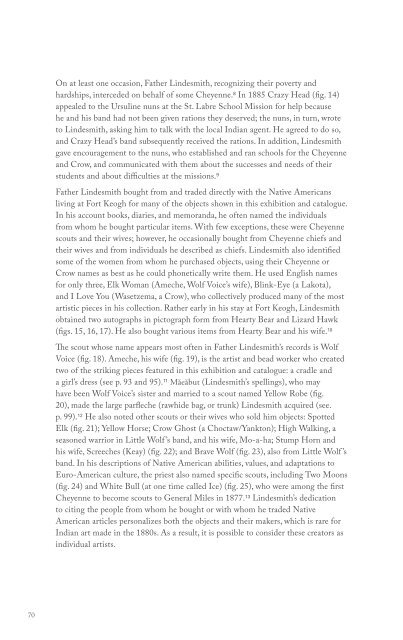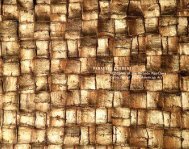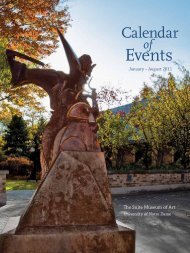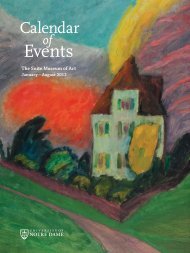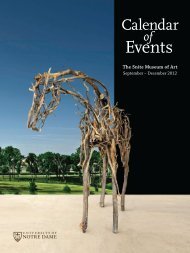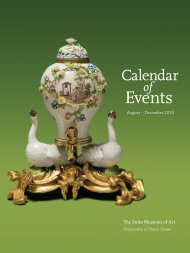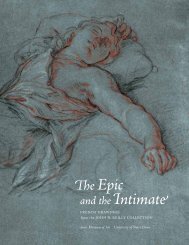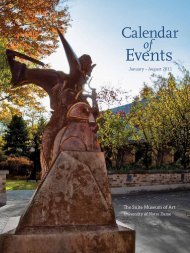HISTORY INTO ART AND ANTHROPOLOGY - Snite Museum of Art ...
HISTORY INTO ART AND ANTHROPOLOGY - Snite Museum of Art ...
HISTORY INTO ART AND ANTHROPOLOGY - Snite Museum of Art ...
You also want an ePaper? Increase the reach of your titles
YUMPU automatically turns print PDFs into web optimized ePapers that Google loves.
On at least one occasion, Father Lindesmith, recognizing their poverty and<br />
hardships, interceded on behalf <strong>of</strong> some Cheyenne. 8 In 1885 Crazy Head (fig. 14)<br />
appealed to the Ursuline nuns at the St. Labre School Mission for help because<br />
he and his band had not been given rations they deserved; the nuns, in turn, wrote<br />
to Lindesmith, asking him to talk with the local Indian agent. He agreed to do so,<br />
and Crazy Head’s band subsequently received the rations. In addition, Lindesmith<br />
gave encouragement to the nuns, who established and ran schools for the Cheyenne<br />
and Crow, and communicated with them about the successes and needs <strong>of</strong> their<br />
students and about difficulties at the missions. 9<br />
Father Lindesmith bought from and traded directly with the Native Americans<br />
living at Fort Keogh for many <strong>of</strong> the objects shown in this exhibition and catalogue.<br />
In his account books, diaries, and memoranda, he <strong>of</strong>ten named the individuals<br />
from whom he bought particular items. With few exceptions, these were Cheyenne<br />
scouts and their wives; however, he occasionally bought from Cheyenne chiefs and<br />
their wives and from individuals he described as chiefs. Lindesmith also identified<br />
some <strong>of</strong> the women from whom he purchased objects, using their Cheyenne or<br />
Crow names as best as he could phonetically write them. He used English names<br />
for only three, Elk Woman (Ameche, Wolf Voice’s wife), Blink-Eye (a Lakota),<br />
and I Love You (Wasetzema, a Crow), who collectively produced many <strong>of</strong> the most<br />
artistic pieces in his collection. Rather early in his stay at Fort Keogh, Lindesmith<br />
obtained two autographs in pictograph form from Hearty Bear and Lizard Hawk<br />
(figs. 15, 16, 17). He also bought various items from Hearty Bear and his wife. 10<br />
The scout whose name appears most <strong>of</strong>ten in Father Lindesmith’s records is Wolf<br />
Voice (fig. 18). Ameche, his wife (fig. 19), is the artist and bead worker who created<br />
two <strong>of</strong> the striking pieces featured in this exhibition and catalogue: a cradle and<br />
a girl’s dress (see p. 93 and 95). 11 Măeăbut (Lindesmith’s spellings), who may<br />
have been Wolf Voice’s sister and married to a scout named Yellow Robe (fig.<br />
20), made the large parfleche (rawhide bag, or trunk) Lindesmith acquired (see.<br />
p. 99). 12 He also noted other scouts or their wives who sold him objects: Spotted<br />
Elk (fig. 21); Yellow Horse; Crow Ghost (a Choctaw/Yankton); High Walking, a<br />
seasoned warrior in Little Wolf ’s band, and his wife, Mo-a-ha; Stump Horn and<br />
his wife, Screeches (Keay) (fig. 22); and Brave Wolf (fig. 23), also from Little Wolf ’s<br />
band. In his descriptions <strong>of</strong> Native American abilities, values, and adaptations to<br />
Euro-American culture, the priest also named specific scouts, including Two Moons<br />
(fig. 24) and White Bull (at one time called Ice) (fig. 25), who were among the first<br />
Cheyenne to become scouts to General Miles in 1877. 13 Lindesmith’s dedication<br />
to citing the people from whom he bought or with whom he traded Native<br />
American articles personalizes both the objects and their makers, which is rare for<br />
Indian art made in the 1880s. As a result, it is possible to consider these creators as<br />
individual artists.<br />
Lindesmith’s personal relationships at the fort and in nearby Miles City reflect his<br />
abiding interest in people <strong>of</strong> all religions and ethnicities. He supervised the schoolteachers<br />
at Fort Keogh and was the chaplain for soldiers and their families, whether<br />
Catholic or not. He was instrumental in establishing the first Roman Catholic<br />
church in Miles City, and he acted as priest for the Ursuline nuns in the area as<br />
well. 14 One <strong>of</strong> his earliest diary entries at the garrison is a list <strong>of</strong> tasks he intended<br />
to complete. As such, it confirms his interests in education and in the spiritual well<br />
being <strong>of</strong> the soldiers and <strong>of</strong> the inhabitants <strong>of</strong> Miles City. It also reveals his attention<br />
to money matters:<br />
1. Mass next Sunday at 8<br />
2. Will teach Catechism<br />
3. Will have confessions<br />
4. Elect a building committee<br />
5. I will assist in making a plan <strong>of</strong> a church<br />
6. Began soon to build<br />
7. Don’t go into debt<br />
8. Take account <strong>of</strong> all income and outgo, form an accounting committee<br />
9. Read expenses <strong>of</strong>f at mass. 15<br />
Of the Native Americans with whom Father Lindesmith traded and from whom<br />
he bought items, Wolf Voice figures most prominently in the cleric’s records. Wolf<br />
Voice was neither a chief nor a headman, and he is not recorded as having been<br />
a member <strong>of</strong> a military society. Among the first Cheyenne scouts General Miles<br />
recruited, in 1877, at about age twenty-two, he probably was a member <strong>of</strong> Two<br />
Moons’s band. 16 Lindesmith described him as being about forty years old in 1891.<br />
Although he was evidently not a member <strong>of</strong> a warrior society, his name recurs<br />
frequently in early Cheyenne history at Fort Keogh, and he appears in more than<br />
one early photograph taken <strong>of</strong> scouts at the fort (fig. 26). 17 Wolf Voice was one <strong>of</strong><br />
five scouts Lieutenant William Clark chose to find Little Wolf ’s band, after that<br />
group <strong>of</strong> Cheyenne escaped from Fort Reno in Oklahoma in 1879 to return to their<br />
former home in Montana; with two other scouts, he was ordered to contact Little<br />
Wolf (fig. 27) directly in order to present terms <strong>of</strong> surrender. By chance, he was the<br />
first scout to enter Little Wolf ’s camp. 18 The artist and writer Frederic Remington<br />
described his vivid impressions <strong>of</strong> Wolf Voice in 1890, when the Indian served as<br />
Remington’s guide in the badlands <strong>of</strong> Montana: 19<br />
Expansive smiles lit up the brown features <strong>of</strong> the Indian scouts as they<br />
recognized me. Old Wolf Voice came around in his large, patronizing way<br />
and said, “How?—what you do out here?” Wolf Voice was a magnificent<br />
type <strong>of</strong> the Indian, with a grand face, a tremendous physique, and enough<br />
self containment for a High-Church bishop. High-Walking nudged Stump-<br />
Horn and whispered in his ear, and they both smiled as they looked at me. 20<br />
70 71


